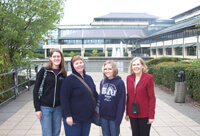| Sources (hover for more info) |
| Civil Registration |
| Census |
| Poor Law Records |
Nonconformist Records
Some nonconformist chapels have records dating back to the 17th century, but the common man is more likely to have affiliated with nonconformity after 1700. A good introduction to nonconformist research is available at NationalArchives.gov.uk and FamilySearch.org. For more details of the different denominations and their records, see Don Steele's volume 2 of the National Index of Parish Registers (FHL 942 D27ste and BYU Religion & Family History Reference CD1068 .A2 S8). A concise guide to beginning research is Michael Gandy's Tracing Nonconformist Ancestors (FHL 942 K2gm and BYU Religion & Family History Reference CS415 .G36x 2001). If you already know the time period and residence of a nonconformist ancestor, also check Historic County Maps and Town and City Maps.
 In general, nonconformist christening records tend to give more information than the parish registers of the Church of England. Especially helpful are those that give the mother's maiden name and the birth order of the child within a family group. Nonconformists were strong supporters of the parliamentary acts that created the civil registration and census in order to ensure the legality of the births of their children and gain access to the right to marry outside the Church of England.
In general, nonconformist christening records tend to give more information than the parish registers of the Church of England. Especially helpful are those that give the mother's maiden name and the birth order of the child within a family group. Nonconformists were strong supporters of the parliamentary acts that created the civil registration and census in order to ensure the legality of the births of their children and gain access to the right to marry outside the Church of England.
Accordingly, the government responded by requesting that the nonconformists send their pre-1837 vital records into the Public Record Office (now the National Archives) for safe keeping. The response of the Quakers was exceptional. They sent in their original records after making a copy to be kept in London for their own use (these records received the archival classification of RG 6). The reaction from other Protestant denominations was mixed but overall fairly good (the records were mostly classified as RG 4). However, Catholics were reluctant to send in their records. The government had barely granted them full civil rights less than a decade earlier.
Search Routines
- Start with Ancestry's collection "England and Wales, Non-Conformist and Non-Parochial Registers, 1567-1970." Images are available online.
- Use the new index to personal names sponsored by a private group in association with the National Archives under "The Official Non-Parochial BMDs Service" at BMD Registers. This site includes RG 4-8, 32-36 as well as some migration records. There is a fee to go beyond the index. The FHL has now provided another index to RG 4-8 on FamilySearch.
 The collection is entitled "England and Wales Non-Conformist Record Indexes (RG4-8), 1588-1977" and can be found here. The index can be enhanced by doing step 3 below.
The collection is entitled "England and Wales Non-Conformist Record Indexes (RG4-8), 1588-1977" and can be found here. The index can be enhanced by doing step 3 below. - Check the place of interest at FamilySearch Maps to see if any nonconformist groups are listed as being established there in 1851. Also search GENUKI. This site may indicate other nonconformist churches in the surrounding area. Then review Search Routines 1-3 listed in church records. The records at the National Archives gathered in 1837 and classified as RG 4 have been microfilmed. Most have been extracted and will be found in the IGI and BVRI. The latter indexes both of the central collections in London referred to as Dr. William's Library and the Wesleyan Methodist Metropolitan Registry. Few Quaker and Catholic records have been extracted.
- See the FHL British reference area under Church Records for their nonconformist register (942 K23re). The register is arranged by county and describes the collection from the National Archives (RG 4) by place, denomination, and the FHL film number. This is available on TheGenealogist.co.uk for a fee. There is also a useful guide to Wesleyan Methodist circuits. A second register provides county maps indicating where the various denominations in the RG 4 classification were located (FHL 942 E7ncm).
The nonconformist register also gives the FHL call numbers for the microfilms of the Quaker records in RG 6. The Catholic Record Society has made a diligent effort to publish the surviving Catholic records. The FHL has acquired many of those publications. For Catholic records visit The National Archives' Catholic records research guide. - Consult the appropriate Inventory of Non-conformist Chapels and Meeting Houses in Central England (FHL 942 K2nc) or the inventory in the North (FHL 942 K2sL). Other volumes are now in print.
- Follow Search Routine 4-5 listed in church records. Further information including websites for some of the denominations will be found at GENUKI. Some nonconformist records found in the various county records offices have been microfilmed and are available at the FHL as in the case of Cheshire, 1671-1900.